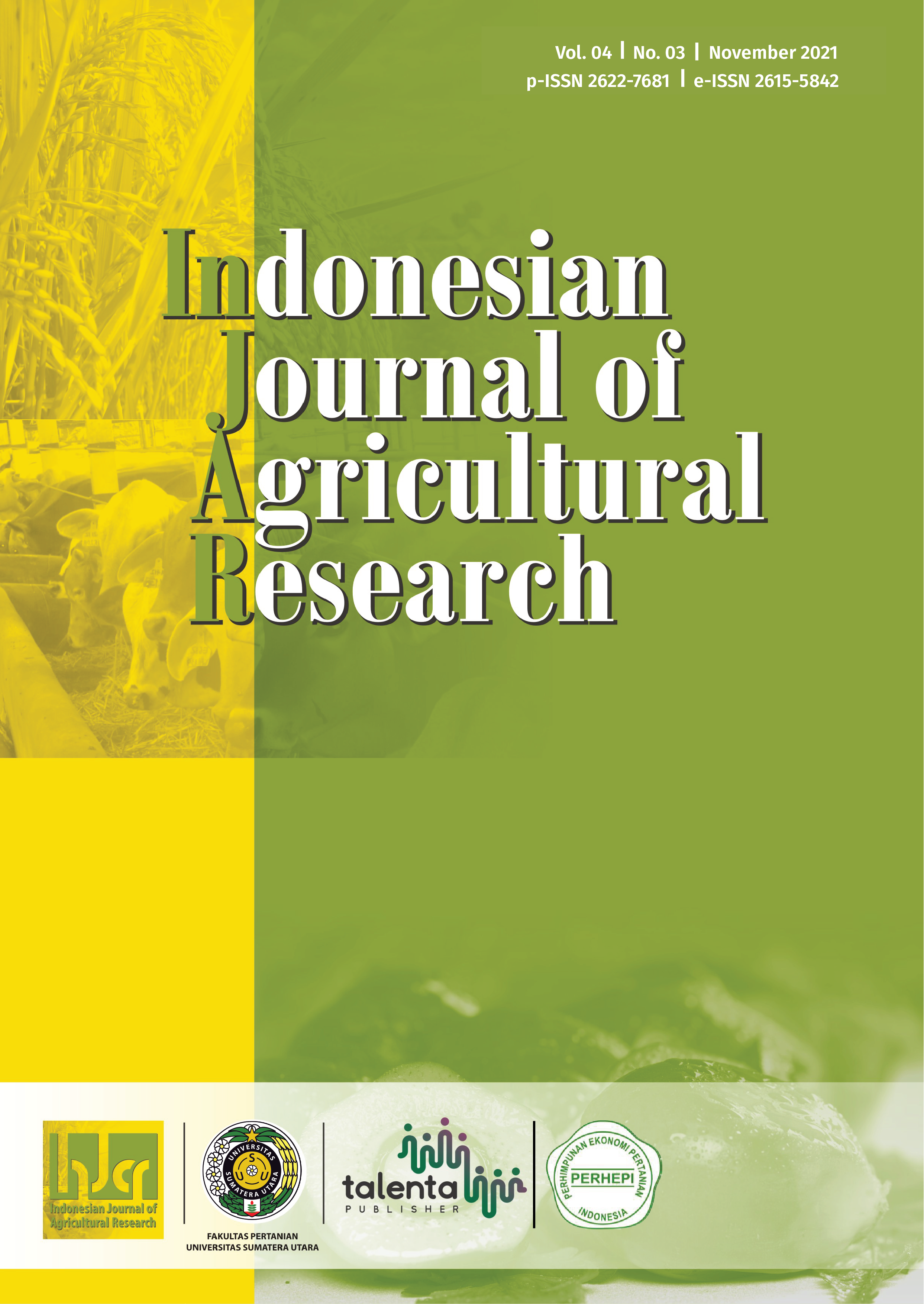The Effectiveness of Maggot (Hermetia Illucens) Growth in Various Growing Media
DOI:
https://doi.org/10.32734/injar.v4i3.7155Keywords:
fruit waste, growing medium, maggot, palm kernel cake, vegetable wasteAbstract
Utilization of maggot as a substitute for protein source feed ingredients can be a solution to overcome the high cost of feed. However, the inappropriate growth media caused the growth of maggots to be inhibited. Palm kernel cake, vegetable and fruit waste have high nutritional content which has the potential as a medium for growing maggots. The purpose of this study was to determine the best growth of maggot on various growing media. The treatments given in this study were P0A = 100% palm kernel cake; P0B = 100% vegetable and fruit waste; P1 = palm kernel cake 75% + vegetable and fruit waste 25%; P2 = palm kernel cake 50% + vegetable and fruit waste 50%; P3 = palm kernel cake 25% + vegetable and fruit waste 75%. The results showed that the use of growing media from mixing 25% palm kernel cake + 75% vegetable and fruit waste (P3) gave better results as a growth medium for the effectiveness of the growth of maggot. This is due to the nutritional needs of maggots for its growth have been met from the nutritional content and organic matter available in optimum quantities in the growing media. It was concluded that the growing media from palm kernel cake with vegetable and fruit waste had effectiveness in increasing the growth of maggot.
Downloads
References
R. Vanessa, J. F. Umboh, Y. L. R. Tulung, and Y.H.S. Kowel, “Protein digestibility and energy of broiler rations using maggot flour (Hermetia illucens) as a substitute for fish mealâ€, Zootec, vol. 36, no. 1, pp. 13-22, Jan. 2016, doi: 10.35792/zot.36.1.2016.9314.
S. Dina, G. Edriani, and M. Putri, “The effectiveness of various cultivation media on the growth of maggot Hermetia illucensâ€, Institut Pertanian Bogor, Bogor, Indonesia, 2011, pp. 1- 9. [Online]. Available: https://repository.ipb.ac.id/jspui/bitstream/123456789/43974/17/ISI.pdf
H. Saurin, S. Toure, C. Sagbla, and M. Legendre, â€Bioconversion of palm kernel meal for aquaculture: Experiences from the forest region (Republic of Guinea)â€, African Journal Biotechnology, vol. 7, no. 8, pp. 1192-1198, Apr. 2008, [Online]. Available: http://www.academicjournals.org/AJB.
M. Anis, B. I. M. Tampubolon, and J. Achmadi, “In vitro rumen fermentability against processed vegetable wasteâ€, Jurnal Pengembangan Peternakan Tropis, vol. 32, no. 1, pp.44-50, Mar. 2007.
I. Moh, S.A.F. Mohammad, and D. Ismail, “Utilization of oil palm by-products as livestock feedâ€, Presented at National Seminar on Livesock and Crop Integration in Oil palm: Towards Sustainable, Johor-Malaysia, 12-14 May, 1998.
F. Lisa, “Population Density Level, Weight, and Maggot Length (Hermetia illucens) in Different Mediaâ€, Skripsi, Universitas Islam Negeri Raden Intan., Lampung, Indonesia, 2017.
A. Muhamamad, A. N. Ratika, M. Lamid, “The effect of palm kernel meal and rice bran media combination which are fermented to the production of black soldier fly maggot (Hermetia Illucens) As a source of fish feed proteinâ€, Jurnal Ilmiah Perikanan dan Kelautan, vol. 4, no. 1, pp. 33-37, Apr. 2012.
R. G. D. Steel and J. H. Torrie, Statistical Principles and Procedures (translated from: Principles and Procedures of Statistics, translator: B. Sumantri). PT Gramedia, Jakarta, 1993.
S. D. Ahmad, D. A. Sipayung and H. G. P. Putra, “The Effect of Several Media on the Growth of Maggot (Hermetia illucens) Populationâ€, PKM Artikel Ilmiah, pp. 9, 2009.
F.R. Melta, “Optimization of the bioconversion process by using hermetia illucens mini larvae to meet fish feed needsâ€, Jurnal Ilmiah Perikanan dan Kelautan, vol.1, pp. 139-144, 2015.
J. Tomberlin, P. H. Adler, and H. M. Myers, "Development of the black soldier fly (Diptera: Stratiomyidae) in relation to temperature", Environ. Entomol, vol. 38, no. 3, pp. 930-934, Jun 2009, doi: 10.1603/022.038.0347.
H. Leslie, S. L. Vanlaerhoven, and J. Tomberlin, “Relative humidity effects on the life history of Hermetia illucens (Diptera: Stratiomyidae)â€, Environmental Entomology, vol. 41, no. 4, pp. 971-978, Aug. 2012, doi: 10.1603/EN12054.
F. A. Katayane, B. Bagau, F.R. Wolayan, and M. R. Imbar, “Production and Content of Maggot Protein (Hermetia illucens) Using Different Growing Mediaâ€, Zootec, vol. 34, pp. 27-36, May. 2014, doi: 10.35792/zot.34.0.2014.4791.
F. R. Melta, S. Hem, and I. W. Subamia, “Magot's potential as one fish feed protein sourceâ€, Presented at National Seminar Hari Pangan Sedunia XXVII, Puslitbangnak, Bogor, pp. 125-130, 2007.
R. I. Eka, Rachimi, and A. Muhammad, "Effect of combination of oil palm dregs and rice bran media on maggot production (Hermetia illucens)", Jurnal Ruaya, vol. 4, no. 2, 2016, doi: 10.29406/rya.v4i2.702.
Syahrizal, Ediwarman, and M. Ridwan, “Combination of palm oil waste and tofu dregs as media for cultivating maggot (Hermetia Illucens) an alternative fish feedâ€, Jurnal Ilmiah Universitas Batanghari Jambi, vol. 14, no. 4, 2014, doi: 10.33087/jiubj.v14i4.233.
Downloads
Published
How to Cite
Issue
Section
License
Copyright (c) 2022 Indonesian Journal of Agricultural Research

This work is licensed under a Creative Commons Attribution-ShareAlike 4.0 International License.



















